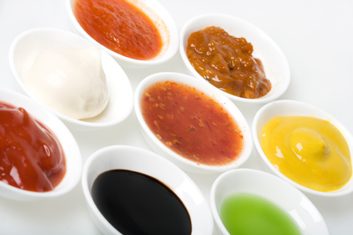4 sauces to start using more often
Exotic condiments are a great way to add heat, flavour and excitement to meals. Here’s how to work them into your dishes

Source: Best Health magazine, November/December 2014
Ever walk down the international aisle at your grocery store and wish you knew how to cook with some of those sauces? No need to feel intimidated’most come with cooking instructions, says Dana McCauley, cookbook author and Food Network TV personality. If in doubt, use less rather than more when you first try them, she advises. A tablespoon or two may be all you need to stir into your favourite dishes or brush onto meat, fish or poultry; for marinades or stews, you may need larger amounts. Once opened, sauces will last about four months in the fridge, McCauley advises. ‘You want them to taste as authentic as possible,’ she says, ‘and if they’re older than that, they may ferment or create ‘off-flavours.”
So grab one of those unfamiliar bottles or jars, and taste the difference they will make to your meals. Read on for four examples. We’ve included McCauley’s suggestions for how to use them, plus what each contains in terms of ingredients, calories, sodium and sugar (it’s always a good idea to check the Nutrition Facts label on the sauce you’re considering).
Sriracha (Thailand/hot)
Canadians seem to be a little more adventurous these days when it comes to the spicy-hot category, says McCauley. A popular hot-sauce brand is Huy Fong, which comes in a green-capped red squeeze bottle with a rooster on the label. It’s spicy, with a delicious sweet/garlicky flavour. To get a sense of its heat, dip bite-size foods into it first. If it’s to your liking, add a tablespoon or two to your marinades for meat, poultry or fish. Or simply squirt a bit on scrambled eggs, pizza, pasta or hamburgers, or into soups.
Main ingredients: chili paste, garlic, vinegar and sugar. Per tablespoon/15 mL: 15 calories, 240 mg sodium, 3 g sugars
Chimichurri (Argentina/spicy)
South Americans love to dip their grilled meats in this sauce for a herbal yet piquant taste. You can also spread it on steaks and hamburgers as a condiment, add it to chicken marinades, or use it with any food on which you would squeeze a lemon, says McCauley.
Main ingredients: parsley, cilantro, oregano, shallots, cayenne, lemon juice, oil and garlic. Per tablespoon/15 mL: 25 calories, 85 mg sodium, 0 g sugars
Mirin (Japan/sweet)
Made from a low-alcohol, sweet rice wine, this sauce is perfect for adding to glazes, marinades or any recipe that calls for sherry, says McCauley. Since it is not as sharp as rice vinegar, mirin rounds out the aromatic quality of dishes. It’s great for making teriyaki; or glazing meats, fish or poultry during the last five minutes of cooking to caramelize it.
Main ingredient: sweetened rice wine (sake). Per tablespoon/15 mL: 50 calories, 5 mg sodium, 6 g sugars
Rogan josh (India/aromatic)
As Indian cooking has grown in popularity across Canada, says McCauley, we are becoming more comfortable using Indian spices and sauces. Rogan josh, which is also the name of a lamb dish originally from Iran, migrated to the Kashmir region of India. Its acidic quality complements stewed lamb beautifully, tempering the richness of the meat. The sauce can also be used when cooking with beef or chicken.
Main ingredients: onions or shallots, tomatoes, chili flakes, garlic, ginger and spices (cloves, bay leaves, cardamom, cinnamon). Per tablespoon/15 mL: 10 calories, 0 mg sodium,
0.5 g sugars




